
William Butterfield was a Gothic Revival architect and associated with the Oxford Movement. He is noted for his use of polychromy.
Longthorpe is an area of the city of Peterborough, in the unparished area of Peterborough, in the Peterborough district, in the ceremonial county of Cambridgeshire, England. Located two miles (3.2 km) west from the city centre, the area covers 1,390 acres. For electoral purposes it forms part of Peterborough West ward.

James Piers St Aubyn, often referred to as J P St Aubyn, was an English architect of the Victorian era, known for his church architecture and confident restorations.

Farndish is a village and former civil parish, now in the parish of Podington, in the Bedford district, in northwest Bedfordshire, England, located about 500 metres (yards) east of the county border with Northamptonshire. The village is near the Northamptonshire villages of Irchester and Wollaston and the Bedfordshire village of Wymington. In 1881 the parish had a population of 72.
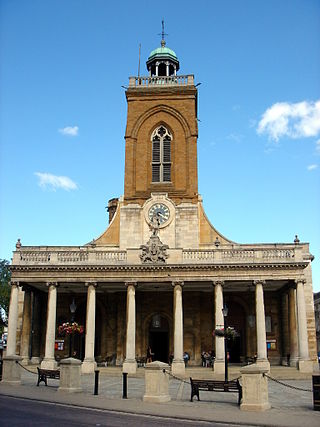
All Saints' Church, Northampton is a Church of England parish church in the centre of Northampton. The current church was largely built after a fire and was consecrated in 1680. It is a Grade I listed building.
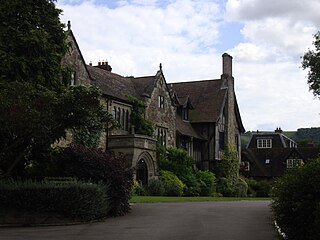
St Joseph's Abbey, Storrington at Storrington in Sussex, England, was originally a rectory, later a small country house and then a convent school.
Newark was a hamlet of the parish of Saint Mary the Virgin in the Soke of Peterborough in the United Kingdom. One mile and a half (2.4 km) north-east-by-east from the city centre; a portion was incorporated with the municipal borough in 1874. The remainder formed part of Peterborough Rural District from 1894 until 1926 when the city's boundaries were extended to include the civil parish of Peterborough Without.
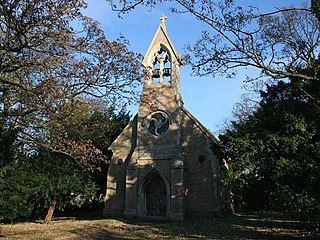
St Mary's Church, Barnstone is a parish church in the Diocese of Southwell and Nottingham of the Church of England, situated in Barnstone, Nottinghamshire. It was completed as a chapel of ease for St Andrew's Church, Langar in 1857 in Gothic Revival style.
Edwin Dolby was an English Victorian architect who practised in Abingdon. His works include the design of Abingdon School.

All Saints' Church is a Church of England church located in Huntingdon, Cambridgeshire, England. There have been multiple churches on the site of this one. The earliest mention of a church dates to 973 AD with the original dedication having been to either St Mary, or The Blessed Virgin and All Martyrs.

The Church of All Saints is a Grade I listed church in Chalgrave, Bedfordshire, England. It became a listed building on 3 February 1967. The church, dedicated to All Saints, is an old structure, its consecration recorded as taking place in 1219. It features a nave, chancel, and aisles. The large square tower contains three bells. The nave has five bays. Some of the arches are Early English Period, with foliage decorated capitals, while other capitals are moulded. The register dates from the year 1539. Its fittings include two antique tombs with statues of knights in armour. The interior also features a faded wall painting featuring various saints.

Church of St Thomas of Canterbury is a parish church and Grade I listed building in Clapham, Bedfordshire, England. It became a listed building on 13 July 1964. Though the church can be traced back before A.D. 1000, there is no record of the original patron saint, Thomas Becket having been so well accepted. The church is built in the Anglo-Saxon style, possibly early 10th century. There are narrow semi-circular-headed windows. The upper story is Early Norman. The parapet is 17th century. The remainder of the church was entirely rebuilt in 1861, by Sir George Gilbert Scott. It features a chancel, nave, and two aisles. The tower, which dates to the 11th or 12th century, measures 26 metres (85 ft) in height.

Church of All Saints is a Grade I listed church in Cople, Bedfordshire, England. It became a listed building on 13 July 1964. The church, dedicated to All Saints, is constructed of sandstone and Dunstable clunch, in the Early English Period and Perpendicular styles. It contains a chancel with side chapels, nave with clerestory, aisles, south porch and a tower containing 5 bells. On the north side of the chancel, there is a marble altar tomb. The nave and chancel have been restored since 1877. The register dates from the year 1560. Its patron was Christ Church, Oxford.
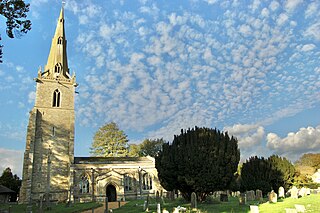
Church of St Peter is a Grade I listed church in Sharnbrook, Bedfordshire, England. It became a listed building on 13 July 1964. The parish church is dedicated to Saint Peter. It is of Gothic architecture style, with a tower and spire. Its interior is decorated with monuments. A hand-tinted aquatint of 'Sharnbrook Church, Bedfordshire' was drawn, engraved and published by Thomas Fisher on November 4, 1812.

Church of All Saints is a Grade I listed church in Houghton Conquest, Bedfordshire, England. It became a listed building on 23 January 1961. The parish church, dedicated to All Saints, was built during the 14th century. There are also several monuments. Houghton Conquest's rectory was united with that of Houghton-Gildable in 1637, in the archdeaconry of Bedford, and diocese of Lincoln. It was under the patronage of the Master and Fellows of St John's College, Cambridge.
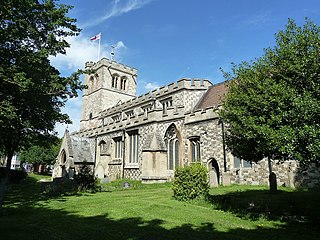
The Church of All Saints, formerly The Church of St. Michael, is a medieval building and an active Anglican parish church in Houghton Regis in the English county of Bedfordshire. It is a 13th century Grade I listed building.

St Mary's Church is located in Huntingdon, Cambridgeshire, England. The church is said to have been the "Mother Church of Huntingdon". It occupies what is probably the original site of Huntingdon Priory of Austin Canons, founded in 1140 by Eustace de Lovetot, and seems to have been used initially as a parochial church upon the removal of the priory to the east end of town during the reign of Henry II.

St Andrew's Church is the Anglican parish church for the town of Biggleswade in Bedfordshire, England. The church is Grade II* listed and comes under the Diocese of St Albans. The church is noted for its monumental brass of John Rudying of 1481 featuring the Figure of Death.

Edward Browning was an English architect working in Stamford.
















